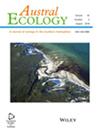Spatial–Temporal Variation of Bird Roadkill Hotspots in the Brazilian Semi-Arid Region
Abstract
Birds are vulnerable to roadkill on highways. Understanding which factors may be associated with bird roadkill and the formation of roadkill hotspots is crucial for informing evidence-based mitigation measures. This research aimed to identify bird roadkill hotspots in semiarid environments, the spatial–temporal variation of roadkill hotspots, and which landscape variables are associated with them. Roadkill data were collected over 3–4 years on different roads. Ripley's K statistic—2D was used to verify aggregations, and HotSpot Analysis—2D to map critical points. Generalised Linear Mixed Models (GLMM) were applied to correlate hotspots with landscape variables, seasons and proximity to protected areas. It was detected that bird roadkill hotspots present significant spatial–temporal variation, and only 11 roadkill hotspots persisted for longer. It was also observed that hotspots are more frequent in agricultural environments as the distance from preservation areas increases, and they are more present in the rainy season. The great spatial–temporal dynamics of hotspots reinforce the need for long-term surveys and corroborate the findings that it is not advisable to implement mitigation measures based exclusively on hotspot analyses. Alternative approaches based on land use and occupation patterns and the relationship between species biology and habitat use should be considered in the management of road projects.


 求助内容:
求助内容: 应助结果提醒方式:
应助结果提醒方式:


